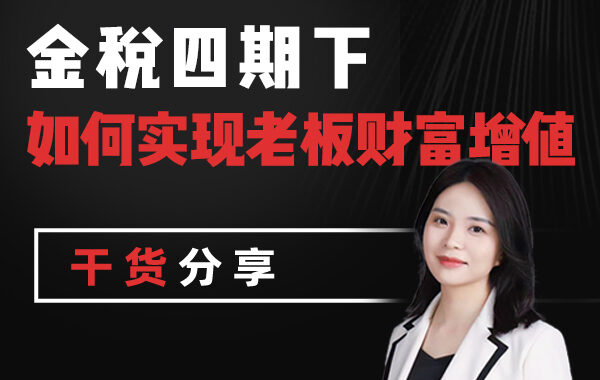
- 2025-04-01
- by www_Admin_Log1n
- wealth management, The fourth Golden tax
I. Overview of activities
The symposium focused on "Enterprise Wealth appreciation Strategies under the fourth Golden Tax Period", attracting many entrepreneurs, financial leaders and senior executives to participate. The event has in-depth discussions from multiple dimensions such as policy interpretation, tax compliance, and wealth management, aiming to help enterprises achieve sound development in the new regulatory environment.
The seminar adopted the form of "expert explanation + case analysis + interactive question and answer" to systematically analyze the regulatory logic of the fourth Golden Tax period, common risk points of enterprises and the practical operation path of compliance improvement. The participants generally gave detailed feedback and vivid cases, which has important guiding significance for actual management.
Ii. Review of core content
(1) The regulatory characteristics and trends of the fourth phase of the Golden Tax
Digital supervision of the whole process
Tax system and banking, social security, market supervision and other departments to share data in real time
Enterprise invoices, funds flow, contracts, logistics and other business elements are fully tracked electronically
Cross-comparison analysis of multi-dimensional data of legal persons, shareholders and affiliated enterprises
Intelligent risk warning
Big data analysis to identify abnormal transaction patterns (such as large cash payments and frequent public transfers)
Industry indicator deviation warning (such as abnormal fluctuation of cost rate and gross margin)
Automatic screening of pricing rationality of related party transactions
Key areas of supervision
The shareholder loan has not been returned for a long time
Business payments are collected from personal accounts
Overinvoicing or accepting non-compliant bills
Hiding income or inflating costs
(2) Compliance framework for wealth management
Enterprise architecture optimization strategy
Design the holding structure according to the business essence (such as the reasonable layout of the parent-subsidiary company in the tax depression)
Take advantage of regional tax incentives (note the "substantive operation" requirement)
Avoid anti-tax avoidance investigations caused by shell companies and excessive tax planning
Key points of standard fund management
Strictly distinguish between legal person property and shareholder personal property
Regulate public to private operations (such as wages and salaries, dividends, loans)
Establish a petty cash management system to control the scale of cash transactions
New ideas for asset allocation
Rational use of insurance, trust and other tools to achieve risk isolation
The legal boundary between operating assets and family wealth
Pay attention to the compliance operation and value mining of intangible assets such as intellectual property
(3) Analysis of typical risk cases
Cases of private accounts receiving checks
An enterprise collects payment for goods through a personal account of more than 10 million yuan, and is identified as abnormal by big data
Eventually, back taxes, late fees and a 0.5 times fine are paid, and the business owner faces criminal responsibility
Cases in which fictitious costs were traced
Enterprises offset profits by falsely invoicing services, and were found by systematic comparison three years later
Need to pay corporate income tax, individual income tax and the corresponding fine
Equity transfer pricing dispute cases
The transfer of shares at a low price was approved by the tax authorities for transfer of income, and the back tax was more than one million yuan
It is suggested that equity transactions need to prepare a complete valuation report to support pricing rationality
Third, practical operation suggestions
(1) Tax compliance infrastructure
Improve the internal control system
Establish an integrated information management system for business, finance and taxation
Standardize contract management (e.g. clarify invoice terms, payment methods, etc.)
Conduct regular tax health checks
Key points of certificate management
Ensure the "four streams" of capital flow, invoice flow, contract flow and goods flow
Cross-border transactions require special attention to transfer pricing documentation
Retain the original documents and relevant supporting materials of expenses incurred
2. Paths for wealth appreciation
Industrial policy dividend capture
We will pay attention to additional deductions for research and development costs and tax incentives for high-tech enterprises
合理利用跨境电商、服务外包等领域的扶持政策
Capital operation compliance points
The operating conditions of special tax treatment are applicable to enterprise reorganization
Tax optimization design of equity incentive scheme
Key points of tax due diligence in M&A transactions
Family wealth inheritance planning
Comparison of tax costs of intergenerational inheritance (gift, inheritance, equity transfer, etc.)
Debt isolation function and tax treatment of family trust
Compliance path for domestic and foreign asset allocation
Iv. Summary
The fourth phase of the Golden tax marks the profound reform of tax regulation from "controlling tax by votes" to "controlling tax by numbers". Enterprises need to establish the following core perceptions:
Compliance is a prerequisite for adding value
Any wealth management scheme must be based on legal compliance
The cost of risk associated with fluke psychology is far higher than at any time in history
The importance of a professional team
Professional collaboration between tax, law and finance is necessary
Be sure to have a professional structure designed before a major transaction
Long-term thinking
Avoid pursuing short-term tax savings while ignoring long-term risks
Establish a tax management system that matches the enterprise's development strategy
Through detailed policy interpretation and case sharing, this event provides enterprises with solutions to adapt to the new regulatory environment. Subsequently, it is suggested that enterprises focus on the following work: regular tax health diagnosis, senior management financial and tax knowledge training, business process compliance review, etc., so as to truly realize "making money safely and adding value in compliance".






